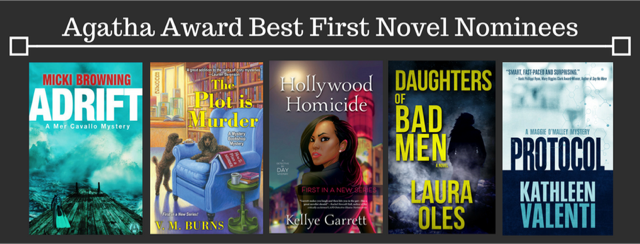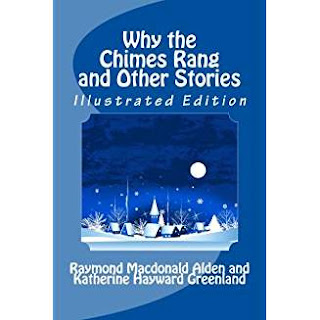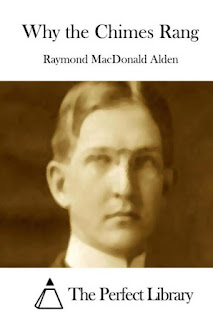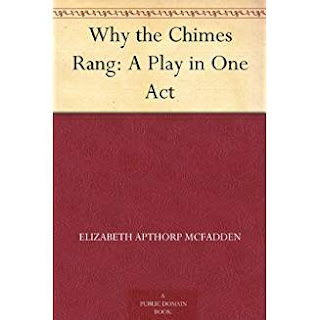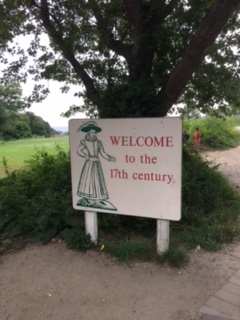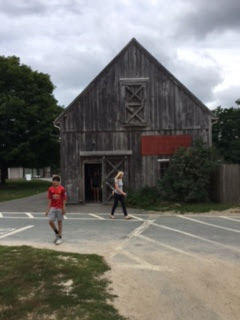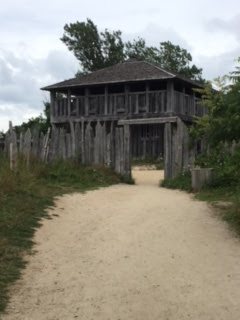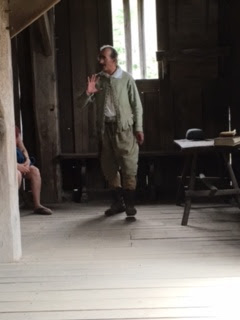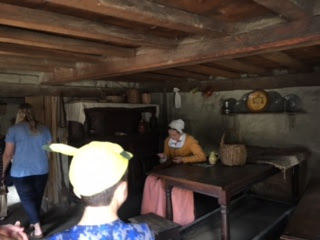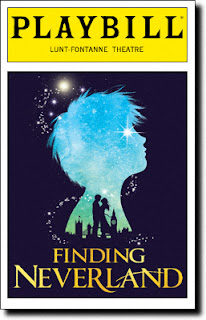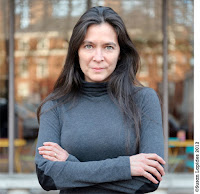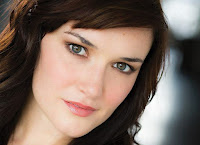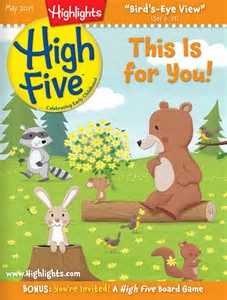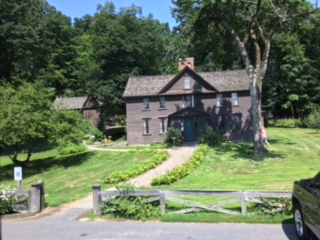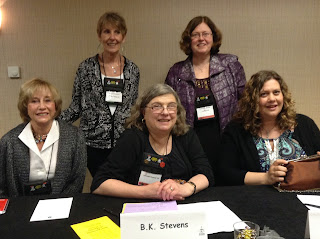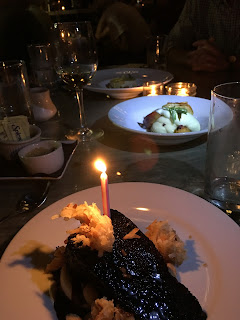Interview with Agatha Nominees for Best First Novel!
excellence is recognized by the Agatha awards. This year’s nominees for Best
First Novel are:
Adrift: A Mer Cavallo Mystery
by Micki Browning (Alibi-Random
House)
The Plot is Murder: A Mystery Bookshop
Mystery by V.M. Burns (Kensington)
Hollywood Homicide: A Detective by Day Mystery by Kellye Garrett (Midnight Ink)
Daughters of
Bad Men by Laura Oles (Red Adept Publishing)
Protocol: A Maggie O’Malley Mystery
by Kathleen Valenti (Henery Press)
Kellye, Laura, and Kathleen. Thanks for stopping by to share your work and
thoughts with us!—Paula Gail Benson
writing habits enabled you to complete a novel?
 |
| Micki Browning |
suggests I have a routine, and sadly, that just isn’t the case. I’m a freestyle
writer
who works
best when
there is a looming deadline. I’m a somewhat recent convert to outlining. I’ve found that plotting the milestones ensures I don’t get lost along
the way. But by keeping the outline spare, it doesn’t stifle my ability to take the occasional road less traveled to
get to where I want to go.
of writing between 7,500 to 10,000 words per week. If I write 1,000 to 1,500
per night, then I can easily make my goal.
 |
| Kellye Garrett |
who got up at 5 am every morning and pounded out 1,000 amazing words before I
even had a dose of caffeine. I am not. My favorite quote is from Dorothy
Parker: “I hate writing. I love having written.” For me, I write after there is
literally nothing else for me to do. Like I will clean my toilet and yours
before I write a single word. For me, the key is having a detailed outline. I
may go a bit overboard. (My 25-plus page outlines are legendary among my
friends.) But the blank page scares me as much as a good horror movie villain.
So I like to know exactly what I need to write and what comes next. I also
allow myself to do a “vomit draft” where I just throw things on the page to
clean up in later drafts. My books aren’t anywhere near decent until around the
draft number three.
writing for digital photography magazines and publications, so the writing
practice had been part of my regular routine. I managed deadlines and
worked with editors, and I came from the perspective of writing being not only
craft but also a business. Still, writing fiction is completely different and I
had a great deal to learn.
support. AMW is truly focused on helping each member produce the best work
possible. Writing can be such a solitary pursuit, so having other authors
to bounce ideas off of has been a wonderful thing.
 |
| Kathleen Valenti |
piece of writing advice came from a romance novelist in my hometown. When she
saw how much (little?) I had on the page after writing for longer than I care
to admit, she gave me some tough author love: stop fannying about and write. (Okay, so maybe she
didn’t say “fannying about,” but
sometimes my bookish memories have an English accent.)
the importance of word counts and to meet them daily, come hell or Dateline marathons. Her advice
proved invaluable. Not only did making (and meeting) word count goals help me
move from page one to page 300, it helped me silence the internal editor that
kept me polishing the same phrase again and again without moving forward. This
habit of writing toward a goal helped me finish my second book ahead of its
deadline and have the confidence to realize that even when plots or characters
don’t seem to cooperate, I’ll get there, one word at a time. As other wise
novelists have pointed out, sometimes you have to let the rusty water out first
for the good stuff to run clean.
alone?
Mer Cavallo Mysteries. Book two, Beached, launched in January. I’m currently writing a stand-alone police
procedural, and then it’s back to Mer with Chum.
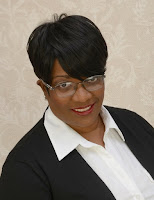 |
| V.M. “Valerie” Burns |
part of The Mystery Bookshop Mystery series.
thing since Hollywood Homicide ends on a bit of a cliff hanger. The second book, Hollywood Ending, comes out in August 2018
and features three of my favorite things: gossip blogs, blind items, and fancy
award shows. The third book will be out sometime in 2019.
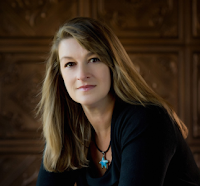 |
| Laura Oles |
Bad Men is the first book in the Jamie
Rush mystery series. Jamie Rush is a skip tracer working in the coastal town of
Port Alene, Texas. Jamie and her partner, Cookie Hinojosa, take on the
emotional task of finding Jamie’s missing niece. Accepting Kristen’s case isn’t
an easy ask. Jamie’s relationship with her family is a complicated
one. She doesn’t trust them, and for very good reason. Still, when
Kristen goes silent, she agrees to take the case because…well, she’s
family. You don’t turn your back on family.
the Maggie O’Malley mystery series. The second book, 39 Winks, releases May 22nd.
your protagonist, or another character from your novel wear to the Agathas
banquet?
and bare feet kind of gal. She’d dig around in the back of her closet until she located the
pumps she’d worn when she defended her dissertation–black, no nonsense, perfectly
serviceable. And she’d kick them off under the banquet table when no one was looking.
sleuthing seniors who helps Samantha in the series is very fond of six
inch hooker heels. She’d rock these shoes.
In Hollywood Homicide, my main character Dayna covets a pair of Pink Panthers,
described as “a hot pink stiletto with panther spots that was the shoe of the
moment.” She wears them the entire book, including when chasing a suspect. They
play such
a big role in the story that we even had her wearing them in an early
version of the cover. So she’d definitely proudly rock her Pink Panthers to the
Agathas.
Burgundy since it’s a special occasion. But she would make sure to pair
them with a jacket and dark jeans. It’s about as dressed up as she
gets. Formal gowns make her nervous.
girly-girl. While I’d gladly don cute sling-backs or a kitten heel for the Agathas banquet, Maggie
would show up in running shoes, even if she were forced to shimmy into a ball
gown. Since she’s a new college grad on a serious budget, she’d be sporting Court Classics rather than,
say, Nike or New Balance. And because she doesn’t care about her appearance—or
anyone else’s opinion—she’d wear those bright white kicks with pride.
information about these novelists and their work. Check them out!
retired police captain, Micki Browning writes the Mer Cavallo Mystery series
set in the Florida Keys. In
addition to the Agatha nomination for Best First Novel, Adrift, has
won both the Daphne du Maurier and the Royal Palm Literary Awards. Beached, her second novel, launched January 2018. Micki’s work has
appeared in dive magazines, anthologies, mystery magazines, and textbooks. She
lives in South Florida with her partner in crime and a vast array of scuba
equipment she uses for “research.” Learn more about Micki at MickiBrowning.com
biologist-turned-divemaster Meredith Cavallo thought adjusting to a laid-back
life in the Florida Keys would be a breeze. But when the host of a
ghost-hunting documentary crew hires her as a safety diver and then vanishes
during the midnight dive, Mer’s caught in a storm of supernatural intrigue.
man’s disappearance as any scientist would—by asking questions, gathering data,
and deducing the truth. But the victim’s life is as shrouded in mystery as his
disappearance. Still, something happened under the water and
before long, she’s in over her head. When someone tries to kill her, she knows
the truth is about to surface. Maybe dead men do tell tales.
(Valerie) Burns was born in Northwestern Indiana and spent many years in
Southwestern Michigan on the Lake Michigan shoreline. She is a lover of dogs,
British historic cozies, and scones with clotted cream. After many years in the
Midwest she went in search of milder winters and currently lives in Eastern
Tennessee with her poodles. Receiving the Agatha nomination for Best First
Novel has been a dream come true. Valerie is a member of Mystery Writers of
America, International Thriller Writers, and a lifetime member of Sisters in
Crime. Readers can learn more by visiting her website at vmburns.com.
Washington has dreamed of owning a mystery bookstore for as long as she can
remember. And as she prepares for the store’s grand opening, she’s also
realizing another dream—penning a cozy mystery set in England between the wars.
While Samantha hires employees and fills the shelves with the latest mysteries,
quick-witted Lady Penelope Marsh, long-overshadowed by her beautiful sister
Daphne, refuses to lose the besotted Victor Carlston to her sibling’s charms.
When one of Daphne’s suitors is murdered in a maze, Penelope steps in to solve
the labyrinthine puzzle and win Victor. But as Samantha indulges her
imagination, the unimaginable happens in real life. A shady realtor turns up
dead in her backyard, and the police suspect her—after all, the owner of a
mystery bookstore might know a thing or two about murder. Aided by her feisty
grandmother and an enthusiastic ensemble of colorful retirees, Samantha is
determined to close the case before she opens her store. But will she live to
conclude her own story when the killer has a revised ending in mind for her?
Garrett writes the Detective by Day mysteries about a semi-famous, mega-broke
black actress who takes on the deadliest role of her life; Homicide Detective.
The first, Hollywood Homicide, was recently nominated for Agatha, Lefty and
Barry awards. The second, Hollywood Ending, will be released on August 8, 2018
from Midnight Ink. Prior to writing novels, Kellye spent eight years working in
Hollywood, including a stint writing for the TV drama Cold Case. The New Jersey
native now works for a leading media company in New York City and serves on the
national Board of Directors for Sisters in Crime. You can learn more about her
at KellyeGarrett.com and ChicksontheCase.com.
Dayna Anderson’s Deadly New Role: Homicide Detective
Anderson doesn’t set out to solve a murder. All the semifamous, mega-broke
actress wants is to help her parents keep their house. So after witnessing a
deadly hit-and-run, she pursues the fifteen grand reward. But Dayna soon finds
herself doing a full-on investigation, wanting more than just money—she wants
justice for the victim. She chases down leads at paparazzi hot spots, celeb
homes, and movie premieres, loving every second of it—until someone tries to
kill her. And there are no second takes in real life.
is a photo industry journalist who spent twenty years covering tech and trends
before turning to crime fiction. She served as a columnist for numerous
photography magazines and publications. Laura’s short stories have appeared in
several anthologies, including MURDER ON WHEELS, which won the Silver Falchion
Award in 2016. Her debut mystery, DAUGHTERS OF BAD MEN, is a Claymore Award
Finalist and an Agatha nominee for Best First Novel. She is also a Writers’
League of Texas Award Finalist. Laura is a member of Austin Mystery Writers,
Sisters in Crime and Writers’ League of Texas. Laura lives on the edge of the
Texas Hill Country with her husband, daughter and twin sons. Visit her online
at lauraoles.com.
Rush understands what it takes to disappear because her parents taught her that
long ago. Leveraging her knowledge of why and how people run from their own
lives, Jamie has built a business based on bringing those in hiding back to
answer for their actions. She takes pride in using her skills to work both
inside and outside the law.
her estranged brother, Brian, calls and says his daughter is missing, Jamie
initially turns down the case. Kristen has always been a bit wild, frequently
dropping off the grid then showing up a few days later. But Brian swears this
time is different, and even though Jamie vowed years ago to keep her conniving
sibling at arm’s length, she can’t walk away if Kristen could be in real
trouble.
Jamie begins digging into Kristen’s life, she uncovers her niece’s most guarded
secrets. Uncovering the truth will put a target on Jamie’s back and endanger
the lives of those she loves.
Valenti is the author of the Maggie O’Malley mystery series. The series’ first
book, Agatha- and Lefty-nominated Protocol, introduces us to Maggie, a
pharmaceutical researcher with a new job, a used phone and a deadly problem.
The series’ second book, 39 Winks, releases May 22. When Kathleen isn’t writing
page-turning mysteries that combine humor and suspense, she works as a
nationally award-winning advertising copywriter. She lives in Oregon with her
family where she pretends to enjoy running. Learn more at
www.kathleenvalenti.com.
minted college graduate Maggie O’Malley embarks on a career fueled by professional
ambition and a desire to escape the past. As a pharmaceutical researcher, she’s
determined to save lives from the shelter of her lab. But on her very first day
she’s pulled into a world of uncertainty. Reminders appear on her phone for
meetings she’s never scheduled with people she’s never met. People who end up
dead.
help from her best friend, Maggie discovers the victims on her phone are
connected to each other and her new employer. She soon unearths a treacherous
plot that threatens her mission—and her life. Maggie must unlock deadly secrets
to stop horrific abuses of power before death comes calling for her.

